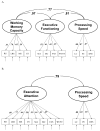The relationship between working memory capacity and executive functioning: evidence for a common executive attention construct
- PMID: 20230116
- PMCID: PMC2852635
- DOI: 10.1037/a0017619
The relationship between working memory capacity and executive functioning: evidence for a common executive attention construct
Abstract
Attentional control has been conceptualized as executive functioning by neuropsychologists and as working memory capacity by experimental psychologists. We examined the relationship between these constructs using a factor analytic approach in an adult life span sample. Several tests of working memory capacity and executive function were administered to more than 200 subjects between 18 and 90 years of age, along with tests of processing speed and episodic memory. The correlation between working memory capacity and executive functioning constructs was very strong (r = .97), but correlations between these constructs and processing speed were considerably weaker (rs approximately .79). Controlling for working memory capacity and executive function eliminated age effects on episodic memory, and working memory capacity and executive function accounted for variance in episodic memory beyond that accounted for by processing speed. We conclude that tests of working memory capacity and executive function share a common underlying executive attention component that is strongly predictive of higher level cognition.
Copyright 2010 APA, all rights reserved
Figures




Similar articles
-
Relations between gross motor skills and executive functions, controlling for the role of information processing and lapses of attention in 8-10 year old children.PLoS One. 2019 Oct 24;14(10):e0224219. doi: 10.1371/journal.pone.0224219. eCollection 2019. PLoS One. 2019. PMID: 31648263 Free PMC article.
-
Individual differences in the executive control of attention, memory, and thought, and their associations with schizotypy.J Exp Psychol Gen. 2016 Aug;145(8):1017-1048. doi: 10.1037/xge0000184. Epub 2016 Jun 16. J Exp Psychol Gen. 2016. PMID: 27454042 Free PMC article.
-
Relationship between Insulin-Resistance Processing Speed and Specific Executive Function Profiles in Neurologically Intact Older Adults.J Int Neuropsychol Soc. 2015 Sep;21(8):622-8. doi: 10.1017/S1355617715000624. Epub 2015 Aug 14. J Int Neuropsychol Soc. 2015. PMID: 26272269 Free PMC article.
-
Attention allocation: Relationships to general working memory or specific language processing.J Exp Child Psychol. 2015 Nov;139:83-98. doi: 10.1016/j.jecp.2015.06.002. Epub 2015 Jun 18. J Exp Child Psychol. 2015. PMID: 26094240
-
Influence of response prepotency strength, general working memory resources, and specific working memory load on the ability to inhibit predominant responses: a comparison of young and elderly participants.Brain Cogn. 2011 Nov;77(2):237-47. doi: 10.1016/j.bandc.2011.08.004. Epub 2011 Aug 31. Brain Cogn. 2011. PMID: 21885178
Cited by
-
Developmental transformations in the structure of executive functions.J Exp Child Psychol. 2020 Jan;189:104681. doi: 10.1016/j.jecp.2019.104681. Epub 2019 Oct 21. J Exp Child Psychol. 2020. PMID: 31648081 Free PMC article.
-
The Experimental Effects of Acute Exercise on Long-Term Emotional Memory.J Clin Med. 2018 Nov 27;7(12):486. doi: 10.3390/jcm7120486. J Clin Med. 2018. PMID: 30486358 Free PMC article.
-
The influence of levels of processing on recall from working memory and delayed recall tasks.J Exp Psychol Learn Mem Cogn. 2011 Sep;37(5):1258-63. doi: 10.1037/a0023923. J Exp Psychol Learn Mem Cogn. 2011. PMID: 21707214 Free PMC article.
-
Clinico-Immunological Status and Neurocognitive Function of Perinatally Acquired HIV-Positive Children on cART: A Cross-Sectional Correlational Study in South Africa.Front Neurol. 2020 Apr 17;11:243. doi: 10.3389/fneur.2020.00243. eCollection 2020. Front Neurol. 2020. PMID: 32362864 Free PMC article.
-
Hippocampus-Related Cognitive and Affective Impairments in Patients With Breast Cancer-A Systematic Review.Front Oncol. 2020 Feb 21;10:147. doi: 10.3389/fonc.2020.00147. eCollection 2020. Front Oncol. 2020. PMID: 32154164 Free PMC article.
References
-
- Albert M, Blacker D, Moss M, Tanzi R, McArdle J. Longitudinal cognitive change among individuals with mild cognitive impairment. Neuropsychology. 2007;21:158–169. - PubMed
-
- Alvarez JA, Emory E. Executive functions and the frontal lobes: A meta-analytic review. Neuropsychology Review. 2006;16:17–42. - PubMed
-
- Ashendorf L, McCaffrey RJ. Exploring age-related decline on the Wisconsin Card Sorting Test. The Clinical Neuropsychologist. 2008;22:262–272. - PubMed
-
- Bäckman L, Ginovart N, Dixon RA. Age-related cognitive deficits mediated by changes in the striatal dopamine system. American Journal of Psychiatry. 2000;157:635–637. - PubMed
-
- Baddeley AD. Working memory. Oxford: Clarendon Press; 1986.
Publication types
MeSH terms
Grants and funding
LinkOut - more resources
Full Text Sources
Other Literature Sources
Medical

